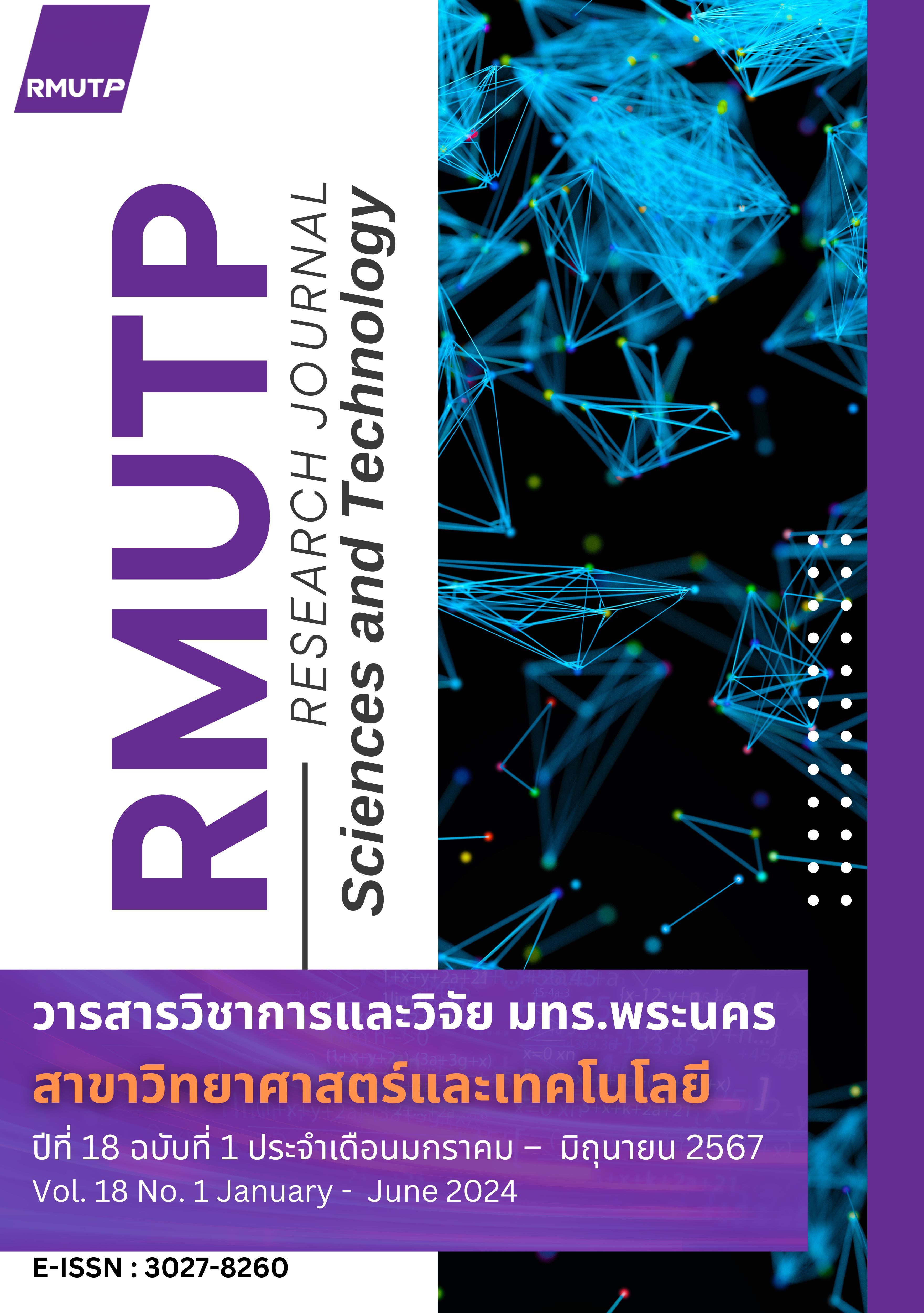The Effect of Watering rate to Napier Pak Chong 1 Grass on Its Yield and Quality Using a Soil Moisture Sensor Module
Main Article Content
Abstract
The research aims to study on watering rates per the Napier Pak Chon 1 grass yield and quality, including fresh-weight, dry-weight and crude protein content by using randomized complete block design in each field cutting Napier grass 3 times: 1st, 70-days aged, 2nd at 115-days aged, and 3rd at 150-days aged. The watering rates of water at 12, 16, and 20 cubic meters per rai. The results showed that in the 1st cutting was not different significantly (P > 0.05), the results as fresh-weight of 4,190+403, 4,019+435, and 3,995+320 kg per rai, dry-weight of 779+109 746+86, and 734+64 kgs per rai, crude protein of 10.88+1.02, 10.73+0.83 and 10.08+0.98 percent, and amount of watering 6 times per plot. The 2nd cutting was not different significantly (P > 0.05), the results as fresh-weight of 7,075+618, 6,924+511, and 6,837+511 kgs per rai, dry-weight 1,085+64, 1,037+123, and 1,036+37 kgs per rai, and crude protein of 12.91+1.54, 12.88+1.33, and 12.86+1.19 percent and amount of watering 3 times per plot. In the 3rd cutting, the results near by the 2nd cutting and was not different significantly (P > 0.05). The results as fresh-weight of 7,590+691 7,446+555 and 7,456+788 kgs per rai, dry-weight of 1,138+162, 1,161+166, and 1,112+108 kgs per rai, crude protein of 12.98+1.55, 12.95+1.58, and 12.94+1.08 percent, and amount of watering 5 times per plot. In conclusion, the optimum watering rate was 12 cubic meters per rai a time.
Article Details

This work is licensed under a Creative Commons Attribution-NonCommercial-NoDerivatives 4.0 International License.
ลิขสิทธ์ ของมหาวิทยาลัยเทคโนโลยีราชมงคลพระนครReferences
C. Sowcharoensuk. (2020,Feb 7) Ri-drought .[Online]. Available: https://www.krungsri.com/th/research/research-intelligence/RI-Drought
Bureau of animal nutrition department. (n.d).Planting Napier Pak Chong 1 (5/2017). [Online]. Available:http://secretary.dld.go. th/index.php/informationdld/article-dld/2625-1-5-2560
Office of the secretary, Department of livestock development.(19 Oct 2020) Planting grass for livestock have a good income (1/2021) [Online]. Available:https://secretary.dld.go.th/webnew/index.php/th/news-menu/dld-editorial-menu/6799-1-2564
K. Kiyothong. (n.d). Handbook of Planting Napier Pak Chong 1 . [Online]. Available: http://extension.dld.go.th/th1/ images/stories/cattle_buff_bord/napiagrass.pdf
S. Udchachon. (n.d). How to planning napier in high production and good quality.[Online].Available:http://nutrition.dld.go.th/Nutrition_Knowlage/ARTICLE/72_1.HTML
N. Puengpa and A. Boontham. (n.d). Study on the Optimun Quantity of Irrgation Water Application for Different Stages of Sugarcane Growth. The 9 th Kasetsart University Kamphaeng Saen Campus Conference. [Online].Available:: http://researchconference.kps.ku.ac.th/article_9/pdf/p_plant12.pdf
Handbook of Planting Napier Pak Chong 1, 1st Ed., Nakhon Ratchasima : Mittrapap Printing, 2013.
S. Mongkolpitak and T. Suesut.(2015). Environment Monitoring And Control For Agriculture Via Smart Device. The 54 th Kasetsart University Conference. [Online]. Available: https://agkb.lib.ku.ac.th/ku/search_ _detail/dowload_digital_file/334101/91338
N. Đuzić and D. Đumić. , “Automatic Plant Watering System via Soil Moisture Sensing by means of Suitable Electronics and its Applications for Anthropological and Medical Purposes”, Collegium antropologicum, June 41(2): 169-172,2017.
N. Pourphan and O. Koaykitjarern, “Evaluation of Effectiveness on Border Irrigation for Napier Grass”, B.Eng. Project, Dept. Civil Eng, Kasetsart Univ. Kamphaengsaen Campus., Nakhon Pathom, 2013.
S. Wijitphan and P. Lowilai, “Effects of Cutting Interval on Yields and Nutritive Values of King Napier Grass (Pennisetum purpureum cv. King grass) under Irrigation Supply,” KKU Research Journal, vol. 16(3), pp. 215–224, Mar. 2011.
P. Kulasuwan, P. Thobunluepop, N. Tonmukayakul, P. Mani-in, A. Pongtip, J.Muangpan, J. Changkaewmanee and N. Vinijchevit, “Effect of Seassonal and Cutting Interval of Napier Paek-Chong 1 on Growth Biomass and Biogas Productivity”, Agricultural Science Journal, Vol.45 No.2 (Suppl.) May-August, pp. 721-724 ,2014.
S. Moonsrikaew, D. Chittathanaseshth, N. Khajornchaikul, A. Phumivithcha and S. Krangwong, “The effect of manure fertilizer on yield and nutritive values of hybrid napier grass (Pennisetum purpureum x Pennisetum Americanum, Pak Chong1),” in Proceeding of 1st , Faculty of Agricultural Technology and Agro-Industr, Rajamangala University of Technology Suvarnabhumi, 2016, pp.1-7.
AOAC., “Official method of analysis”, (21th) Association of Official Analytical Chemistry, Washington D.C.: USA.,1984.
V.M. Ngo and H. Wiktorsson, “Forage yield, nutritive value, feed intake and digestibility of three grass species as affected by harvest frequency”, Trop. Grasslands. 37: 101-110, 2003.
J. Noola-aong, A. Poh-etae and I. Aleemama, “Effect of Fertilizer on Yield and Chemical Compositions of Napier Grass (Pennisetumpurpureum)”, YRU Journal of Science and Technology , Vol. 1 No. 2 ,pp 23-30, 2016.
S. A. Wadi, Y. Ishiiand, S. Idota, “Effect of cutting interval and cutting height on dry matter yield and overwintering ability at the established year in Pennisetum species”, Plant Prod. Sci. 7(1): 88-96, 2004.
B. Gonzalez, J. Boucaud, J. Salette, J.Langlois and M. Duyme, “Changes in stubble carbohydrate content during regrowth of defoliated perennial ryegrass (Loliumperenns) L.) on two nitrogen levels”, Grass Forage Sci. 44: 411, 1989.
P.D. Walton, “Production and management of cultivated forages”, Preston Publishing Company Inc. Virginia. U.S.A. pp. 335, 1984.


